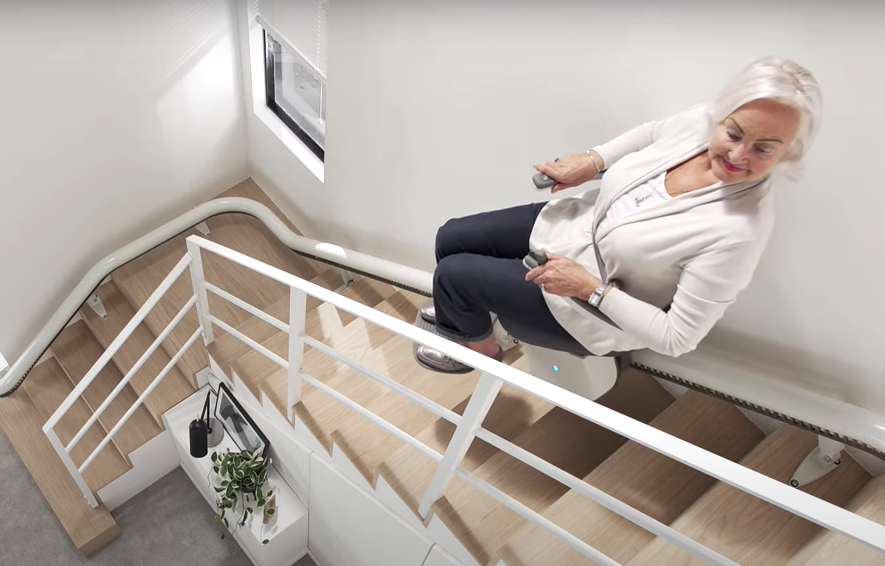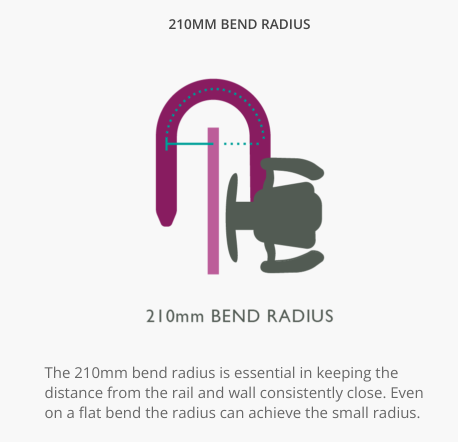Bariatric Stairlifts for Narrow or Twisting Stairs – what are your choices?
When we talk about “heavy weight stairlifts,” we’re referring to stairlifts specifically designed to carry users who are above the standard weight capacity — typically over 20 stone (127kg). These models can also accommodate additional weight from medical equipment, such as oxygen tanks or mobility aids.
This category often overlaps with what’s called bariatric equipment — a term used in healthcare to describe products designed for larger-bodied people, typically supporting higher weight limits and providing extra space, durability, and stability.
So for larger people with narrow or twisting stairs, the options for stairlifts can be more limited. Here we ask the experts at UK Stairlifts for advice:
What is the usual weight limit for a person on a stairlift?
Most stairlifts will carry someone up to around 20 stone in weight. But if you’re heavier than that, or are pushing the weight limit, it’s a good idea to plan forwards and get yourself a heavy weight stairlift. Certain heavy weight models will carry up to 25 stone, with some carrying up to 30 stone.
Should you put some weight on later too, you might be straining the limit of a standard stairlift. Consider also what you might be carrying up a flight of stairs and if you need any medical equipment which might add to the stairlift weight.
Oxygen tanks, for example, are often used for those with breathing difficulties or cardiovascular conditions and can add to the weight on your stairlift.
If you’re going to have a stairlift for several years, it’s worth considering if you’ll put any weight on in that time. “A stitch in time saves nine” as the saying goes! So a bit of forward thinking can save you problems later when it comes to purchasing a stairlift.
Which Heavy Weight Stairlifts To Choose?
If you decide to opt for a heavy weight stairlift, there’s a major consideration you will need to take into account:
Will a heavy weight stairlift fit on your staircase?
In some cases the answer will be a resounding “no”, because, as you would expect, a heavy weight stairlift tends to be larger in size than a standard stairlift. This has some “huge” implications, no pun intended!
Stairlift Comparison:
- Access BDD Flow X
- One of the nimblest stairlifts
- Fits on staircases as narrow as 62cm
- Weight capacity: 125kg / just under 19 stone 9 lbs

- Bruno Stairlift
- Highly recommended for sturdiness
- Weight capacity: up to 30 stone

- Platinum Ultimate
- Slightly nimbler than Bruno
- Weight capacity: up to 25 stone
Benefits of the Platinum Ultimate
The Platinum Ultimate is the model to choose for navigating a narrower staircase if you’re looking for a heavy weight stairlift and have a space issue.
Features:
- Single rail design
- Pivoting at top and bottom of the staircase
- Does not include pivot and tilt (ASL) like Flow X
- Downward-facing seating option provides more legroom for tight spaces
- Suitable for curved staircases

With the Bruno stairlift, there’s no downward facing option, so the staircase width is a limiting factor. If too narrow, Bruno cannot be installed.
The Platinum versus the Bruno Stairlifts
To determine what fits, you need to:
- Measure the width of your staircase
- Measure from the back to the knee

- Add 100–150mm to account for the lift and wall clearance
If the total exceeds your staircase width, a Bruno stairlift won’t fit.
You’ll have to either lose some weight or opt for the Platinum Ultimate, which is nimbler but has a lower weight limit of 25 stone.

Key Comparison Table: Heavy Weight Stairlifts & Narrow Stairs
To summarise whether a heavy weight stairlift will fit your staircase, consider:
Key Factors:
- Size – of the user (lower back to knee measurement)
- Width – of the staircase
- Weight – of the user
🪑↕️ Stairlift Comparison Table: Weight Limits, Constraints & Benefits
| Model | Weight Limit | Min Stair Width | Turning/Pivoting Features | Key Benefits | Constraints |
|---|---|---|---|---|---|
| Flow X (Access BDD) | 125kg / 19 stone 9 lbs | 62cm | ASL (Advanced Swivel & Levelling) – pivots while in motion | – Most agile on the market – Ideal for very narrow/awkward stairs |
– Not suitable for users over 19 stone 9 lbs |
| Platinum Ultimate | 160kg / 25 stone | ~66–70cm (est.) | Swivels at top and bottom only | – Downward-facing option saves space – Suitable for narrow curved staircases |
– No in-motion pivoting like Flow X – Less agile than Flow X |
| Bruno Elite | 190kg / 30 stone | Varies, generally ≥75cm+ | Fixed forward-facing seat only | – Highest weight capacity – Very sturdy and reliable |
– Larger footprint – Not suitable for very narrow stairs |
Final Recommendations:
- Bruno (30 stone): ideal for heavier users, but often requires a wider staircase and lacks advanced pivoting or tilt functionality. Not suitable for narrow staircases
- Platinum Ultimate (25 stone): Better for narrow stairs, curved configurations. It offers a balance between weight support and spatial flexibility, especially for curved or tight stairs.
- Flow X (19 stone 9 lbs): Best for very narrow staircases (down to 62cm), but limited capacity
Here at UK stairlifts we always recommend getting an engineer to measure your staircase when considering a heavy weight stairlift.
As a general rule of thumb:
The heavier the weight limit, the harder it is to fit the stairlift.
About the Author – Tim Halloran
 Tim Halloran is a mobility specialist giving expert advice about installing stairlifts across the UK. Based in Yorkshire, Tim works with UK Stairlifts to help disabled people and older adults find safe, reliable, and accessible solutions tailored to their homes. Tim is passionate about practical accessibility and is committed to helping people maintain independence in their own homes.
Tim Halloran is a mobility specialist giving expert advice about installing stairlifts across the UK. Based in Yorkshire, Tim works with UK Stairlifts to help disabled people and older adults find safe, reliable, and accessible solutions tailored to their homes. Tim is passionate about practical accessibility and is committed to helping people maintain independence in their own homes.
You can reach Tim through UK Stairlifts or connect with him through his company on LinkedIn.
Additional Resources: Safety and Regulations for Heavyweight Stairlifts
When choosing a bariatric stairlift for narrow or twisting stairs, working with an expert dealer is essential. These specialists understand all relevant safety regulations and will ensure your installation is fully compliant. They’ll handle assessments, paperwork, and technical requirements, giving you peace of mind that your heavyweight stairlift is both legally compliant and perfectly suited to your unique staircase.
Here are some of the regulations they must follow:
The NHS guidance on home adaptations offers essential information about stairlift installation, including how to arrange a home assessment and explore potential funding options for those with mobility challenges.
For safety standards, the Health and Safety Executive (HSE) provides comprehensive guidance on thorough examination and testing of lifts, ensuring your stairlift installation complies with the Lifting Operations and Lifting Equipment Regulations 1998 (LOLER).
The LOLER regulations themselves outline specific responsibilities regarding lifting equipment safety and maintenance, which is particularly relevant for heavyweight stairlifts.
For building regulation compliance, Approved Document M provides guidance on access requirements for buildings, which should be considered when planning a stairlift installation for narrow or twisting staircases.
